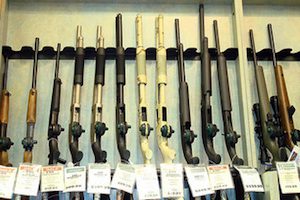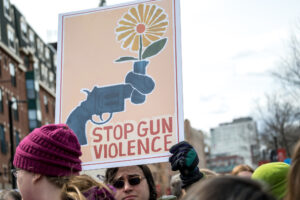The Future of Gun Control in the Aftermath of Sandy Hook
As a result of a grotesque confluence of cultural iconography celebrating the virtues of an armed citizenry, political cowardice in the face of pro-gun lobbies like the NRA, and a judiciary that has redefined the meaning of the Second Amendment, we have become a nation bereft of effective gun control, reduced to waiting for the next firearm fueled massacre.The question arises with renewed urgency: When and how will the madness stop?
In “Leviathan,” his classic work of social-contract theory, British philosopher Thomas Hobbes coined the phrase “war of all against all” to describe the brutal “state of nature” that would unfold in a world without central authority, where people would be licensed to do whatever they pleased. Although Hobbes meant the expression to apply to the perceived dangers of the English Civil War (1642-1651), the phrase easily could be imported to describe the status of gun control in contemporary America.
As a result of a grotesque confluence of cultural iconography celebrating the virtues of an armed citizenry, political cowardice in the face of pro-gun lobbies like the National Rifle Association, and a judiciary that has redefined the meaning of the Second Amendment, we have become a nation bereft of effective gun control, reduced to waiting for the next firearm fueled massacre. Depending on one’s definition of mass shooting, Friday’s bloodbath at Sandy Hook Elementary School in Newtown, Conn. — which took the lives of 20 children and eight adults — was the seventh such atrocity committed this year, dating back to April’s killing spree at an Oakland, Calif., Christian college in which seven people were shot to death.
The question thus arises with renewed urgency: When and how will the madness stop? Since the Sandy Hook killings, more than 100,000 people have signed petitions demanding that the Obama administration produce legislation limiting access to guns. Yet even if the president makes good on the promise he issued the day of the killings to “take meaningful action,” solutions both short-term and long will prove elusive for at least three reasons:
The Numbers
According to a 2011 Gallup survey, 47 percent of Americans own some kind of firearm, and the total number of nonmilitary guns in circulation exceeds 300 million. There are nearly 130,000 federally registered gun dealers across the country, three and a half times the number of grocery stores. Although the sales transacted by registered dealers are subject to the FBI’s National Instant Criminal Background Check System, which screens out buyers with disqualifying felony convictions or histories of confinement in mental institutions, 40 percent of gun sales are unregulated transactions made by private, unlicensed vendors, many at gun shows and conventions.
The Law
With the expiration in 2004 of the federal assault weapons ban, which had prohibited the manufacture for civilian use of semiautomatic firearms and large capacity ammunition clips, an already inadequate national system of gun control was rendered even more lax. At the same time, legal challenges to gun laws and ordinances were making headway in our increasingly conservative judicial system, culminating in the Supreme Court’s landmark 2008 ruling in District of Columbia v. Heller that the Second Amendment provided for an individual right to bear firearms. Before Heller, it had been widely assumed that the Second Amendment applied only to the right of states to maintain militias.
Two years after Heller in another landmark case, McDonald v. Chicago, the high court held that the individual right to bear arms applies not only to federal jurisdictions but also to the states. Since then, lower courts have increasingly fallen in line. Notably, in a 2-1 decision released just days before the Sandy Hook slaughter, the 7th U.S. Circuit Court of Appeals struck down Illinois’ ban on concealed weapons, the last such prohibition left standing in the country.
The Lack of Political Will
Beset by an overwhelming proliferation of firearms and a legal framework more dedicated to perpetuating a Hobbesian state of nature than preventing one, the single greatest obstacle to sensible gun control has been a lack of political will. In the runup to the November elections, neither Romney nor Obama had the courage to make gun control a campaign issue. To do so would have meant taking on the NRA, considered by many the single most powerful lobby in Washington and long noted for the mantra that “it’s people, not guns, who kill people.”
To the NRA — and others on the right who attribute gun violence to the decline of prayer in public school or as former Arkansas Gov. Mike Huckabee opined in the aftermath of Sandy Hook to the separation of church and state — the problem isn’t lax gun control or too many guns at large in society, but too few. If only more law-abiding citizens packed cold steel in public places, the criminally minded would think twice before opening fire. Never mind that many of the perpetrators of mass violence are mentally ill, and don’t think rationally before acting. Astonishingly, even some liberal commentators, like The Atlantic’s national correspondent Jeffrey Goldberg, despairing at the long list of mass shootings and the excessive dissemination of guns, have accepted the NRA’s premise, concluding it’s too late to curtail violence by way of gun control and that the solution to mass violence lies in the expansion of concealed weapons permits.
Like it or not, such arguments can’t be easily dismissed. But whether it is in fact too late to avoid a Hobbesian future on guns remains undecided, and in any event we owe it to ourselves and our children to try to shape that future in the best possible way. In the short run, we can start by demanding that Obama and the rest of our elected representatives take steps to restore and expand the assault weapons ban; bolster the background-check system and apply background checks to gun shows and private sales; outlaw straw purchases (in which a nominal buyer poses for an ineligible end user); limit the number of guns that any single person can buy in a given time period; and ensure the availability of mental health counseling for all Americans.
Longer term, any solution will require nothing less than a cultural and political reconfiguration similar to but even larger than the campaign against smoking, aimed at demythologizing the glamour and social standing of gun ownership and, more broadly, restoring a sense of community across society. This will mean making the issues of gun control and criminal violence part and parcel of the basic movement for social justice. As always, there is no guarantee of success. But if we were able to send the Marlboro Man into retirement, there is at least some small prospect that we can send Thomas Hobbes back to the archives of the 17th century where he rightly and respectfully belongs.
Your support matters…Independent journalism is under threat and overshadowed by heavily funded mainstream media.
You can help level the playing field. Become a member.
Your tax-deductible contribution keeps us digging beneath the headlines to give you thought-provoking, investigative reporting and analysis that unearths what's really happening- without compromise.
Give today to support our courageous, independent journalists.






You need to be a supporter to comment.
There are currently no responses to this article.
Be the first to respond.